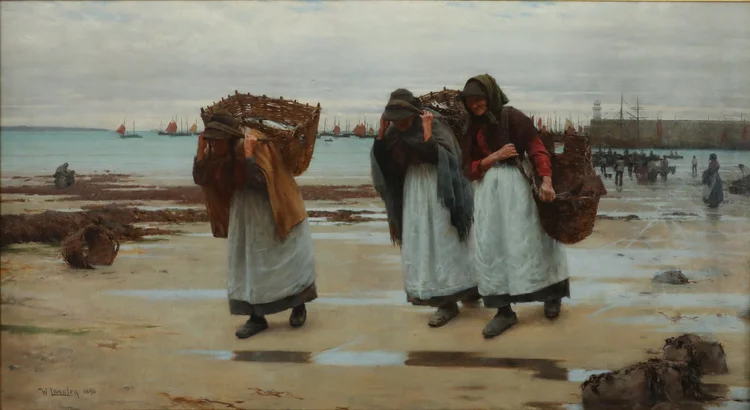Worcester City Museum and Art Gallery has a tiny two room exhibition space but they use it well. The current show From the Cornish Coast to the Malvern Hills: British Impressionism from the 19th and 20th century augments works from their own collection with loans from Southampton Art Gallery and the Bowerman Trust, whose works I'm not familiar with. The result is a satisfying range of late nineteenth and early twentieth century British art, ranging from high Victorian traditionalists like Benjamin Williams Leader through Newlyn School naturalism to Dod Procter and Walter Sicket. It's an eclectic selection - you might go so far as to call it random. So, there's something for everyone; which means inevitably that there'll be something which isn't for you. For my money, Laura Knight is not well served by the overly cute Young Girl Seated with her Dog or the problematically exoticised Beulah.
Personal taste aside, the real issue is what this collection of paintings is actually trying to represent. The exhibition title suggests it is landscape based, which is largely but not exclusively the case. Why, for instance, is Sickert 's Old Soldier included? And then there is the thorny issue of British Impressionism. The wall text which opens the show, sets up a nice summary of French influence and plein airism, and the exhibition begins with a lovely early Camille Pissarro View from the Versailles Road, Louveciennes (1870) - although not one from his time in England. But both the text and that first painting create a false narrative: most of the work here could not even loosely be described as Impressionist. Looking at Charles Napier Hemy or Stanhope Forbes it is easy to fall into the trap of thinking their work less radical than, and perhaps inferior to, what was happening on France, whereas in reality these British artists were judging themselves by a very different set of criteria. Walter Langley was working firmly within a realist tradition giving status, dignity and academy space to the old, the poor and the socially marginalised. Forbes took his queue from the French naturalist style of Jules Bastien-Lepage: plein airism, but much less concerned with immediacy, light and movement than the Impressionists. Others were updating British landscape and seascape traditions. Calling these disparate painters 'impressionist' might guarantee people through the door, but it does the artists no favours and may well leave visitors feeling short-changed.
However, if you put semantics aside, there is plenty of art to enjoy. Forbes' Chadding on Mount's Bay (1902) has been voted the most popular work in Worcester's collection and it's easy to see why. It's a glorious nostalgia-fest, evoking the endless, sun-filled days of childhood, skillfully creating imagined narratives and character relationships, all painted with his French-style, sharp-focussed, square brush technique. His later work becomes increasingly impressionistic just at the time when Impressionism was becoming increasingly old-fashioned and takes on an empty jauntiness, rather like a railway poster (which he did design). At his best though, as in Lighting Up Time, Forbes evokes an epic Thomas Hardy-esque grandeur.
The best thing about this show is variety. Women artists are well represented, including Elizabeth Forbes. You have huge set pieces, like John Arnesby Brown's Herald of Night, and a tiny David Cox sketch. Charles Ginner's stylised and heavily painted view of the Malvern Hills with it's shiny flattened foreground takes the show firmly into the twentieth century. And yes, there is even some genuine Impressionism. It's a free show, by a gallery which consistently tries to do interesting and innovative exhibitions within a limited space, making the most of their limited collection and championing local artists and local scenery. So go, enjoy, but just don't get the wrong impression.




No comments:
Post a Comment